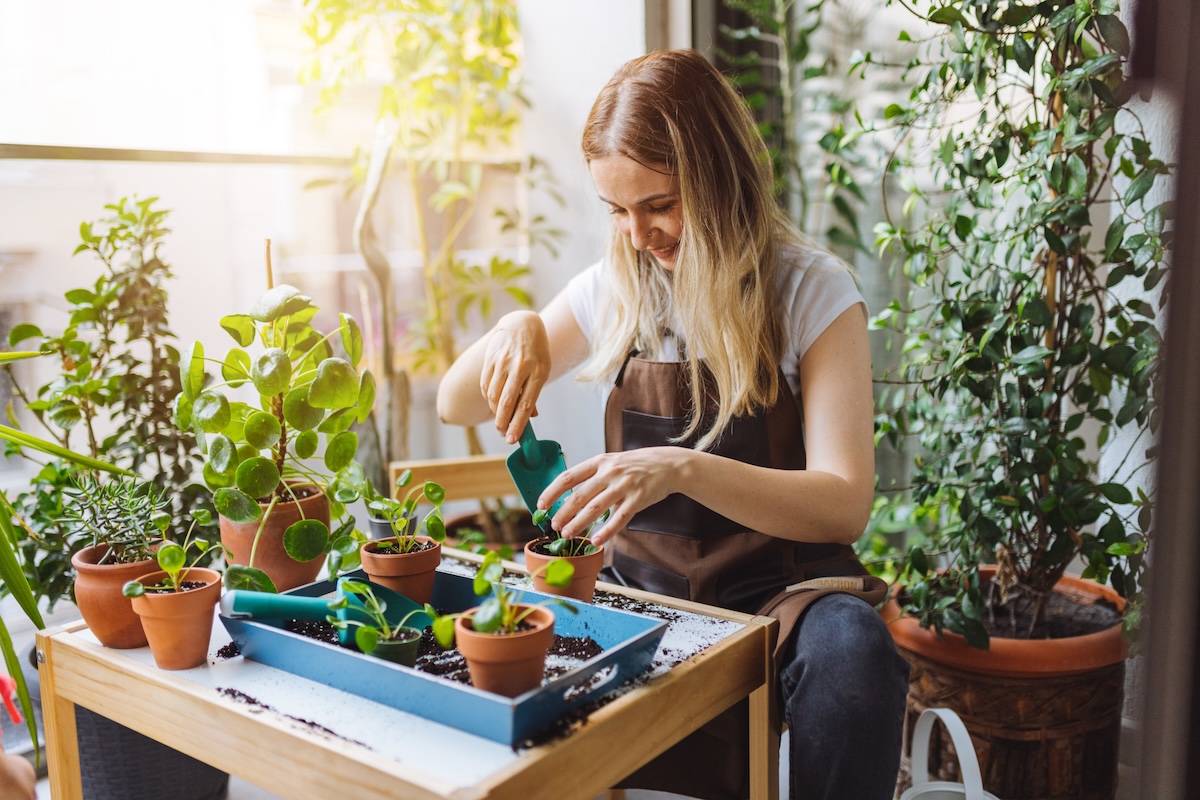

We may earn revenue from the products available on this page and participate in affiliate programs. Learn More ›
The right soil helps container plants thrive, but sometimes we neglect to take the steps to ensure that our greenery is potted in the appropriate medium to support it.
1. Using garden soil instead of potting soil.
Garden soil is an amendment mixed with native soil for use in the ground. It contains minerals, microbes, and organic matter. “Garden soil is too dense, causes unwanted drainage problems, compacts the roots, and further discourages growth in potted plants,” explains Samuel Davis, horticulturist and CEO of London Gardeners.
To prevent issues, he suggests using potting soil. Potting mixes, also called soilless mixes, contain peat moss, vermiculite, and perlite to make them lightweight, retain moisture, and supply air space around the roots. But choosing the wrong one can cause problems like moisture buildup and soil compaction, which produces root damage and inhibits plant growth.
2. Storing potting mix improperly.

Even the best potting soil can become moldy, pest-infested, or compacted if improperly stored. It’s common for bags of potting soil to harbor gnats and other insects, egg sacks, larvae, or seeds. It can also attract pests, including rodents and insects, that feed on organic matter. If it becomes compacted, it’s unable to aerate. If stored in wet conditions, it can mold or produce methane or other toxic gasses.
How to store potting soil safely: make sure it’s dry. Then place it in a clean, sealable bag or container, and set it off the ground—preferably indoors, if possible.
3. Using old potting soil without refreshing it.
While it may sound appealing to re-use potting soil, Davis calls it “a fatal mistake” in many cases, unless adding amendments or topping up with new soil. “The soil begins to lose structure and fertility and becomes prohibitive to the plant’s growth.” In time, soil is exhausted of some nutrients and can become a home for pests or diseases, adds John Haryasz, designer at Privacy Shrubs.
When reusing potting soil, Haryasz advises removing plant matter and incorporating new compost or fertilizer that contains nutrients. “This will not only replenish lost nutrients, but repair the soil, making it suitable for more plants.”
4. Choosing the wrong kind of soil for the plant type.

All-purpose potting soil simply isn’t going to cut it for every plant. Cacti and succulents require a fast-draining, gritty soil. Orchids need a chunky, fast-draining medium containing bark, sphagnum peat moss, and other ingredients that drain quickly. Some plants, like ferns, palms, and peace lily, need more moisture in their soil.
Wilson suggests consulting a guide on how to grow plants. “Knowing which soil belongs to which type of plant is very crucial.” If making your own potting soil or simply amending store-bought, adding vermiculite and perlite can boost aeration, drainage, and moisture retention.
5. Making your own potting soil incorrectly.
Some gardeners prefer to make their own potting soil. Going the DIY route can result in an excellent blend that will keep your plants happy and healthy, but if you fail to include the right proportions of necessary ingredients or exclude some, the soil could hinder growth or cause problems for your plants.
A good potting mix should be lightweight, dry, and fluffy. Add peat, coir, bark, perlite, and vermiculite to improve both moisture-retention and drainage. A limited amount of compost can be added for nutrients, but it can reduce air space in the soil, so should be used sparingly.
6. Forgetting to add nutrients.

“Healthy soil is indispensable, with microorganisms such as fungi and beneficial bacteria that assist plant growth by nutrient absorption,” explains Nathan Thorne, horticulturist and CEO at Handyflowers. Commercial potting soils are typically sterilized, which eradicates those useful microbes.
To overcome that issue, add compost—but not so much that it compacts the soil. Thorne mixes Mycorrhizal fungi into the potting mix. “These fungi grow on roots of the plant, forming symbiosis and increasing the plant’s ability to absorb nutrients and moisture.” In addition, you can use a balanced fertilizer once a month to achieve healthy, thriving plants.
7. Ignoring soil pH.
An uncommon mistake is using one potting soil for all plant types without adjusting the pH value to suit individual plants. The soil’s pH is one determining factor affecting the amount of nutrients the soil provides to the plants. Most potting soil has neutral pH. “[If] one applies neutral potting soil and does not take into consideration the specific plant, then the plant is bound to fail,” Thorne says.
You can change the pH level in the soil by adding organic matter, such as coffee grounds and pine needles, to lower the pH, or crushed limestone or eggshells to raise the pH level.
